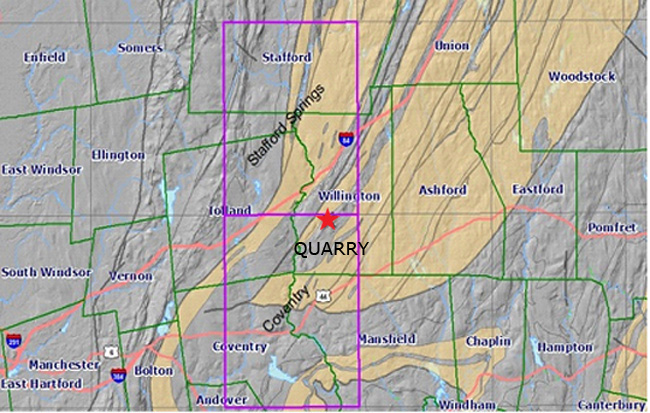 Geologic Formations Containing Pyrrhotite - (Reference - CT DEEP Geologic Maps)
Geologic Formations Containing Pyrrhotite - (Reference - CT DEEP Geologic Maps) 
|
HOME QUALITY INSPECTIONS |
|
Tolland, CT |
|
(860) 871-7433, Cell (860) 463-9910 |
|
KNOW BEFORE YOU SHOW |
Know Before You Show
The rock is excavated, crushed and then used in various forms of construction.
One common material produced from a quarry is aggregate (crushed stone) used in the production of concrete for the construction of roads, building foundations, etc. A “batch plant” is a facility (usually within a quarry or nearby) that manufactures concrete.
Pyrrhotite is a sulfide mineral (one of a group of minerals containing sulfur) that requires iron and sulfur to form. Excessive amounts of pyrrhotite in quarry-produced aggregate can be highly reactive in concrete.
When pyrrhotite is naturally exposed to water and oxygen, it breaks down producing sulfuric acid and various secondary minerals. The powerful formation of these secondary minerals takes up more space than the pyrrhotite they replace and this “expansion” cracks and degrades concrete.
What are the odds of a quarry in northeastern Connecticut . . .
Starting operation in a section of the quarry containing deposits of pyrrhotite . . .
Producing construction aggregate containing excessive amounts of the mineral . . .
Trucking the aggregate to a nearby batch plant . . .
And manufacturing concrete that ended up in the foundations of perhaps thousands of homes and other buildings?
Well, whatever the odds . . . It happened in 1983. |
 Geologic Formations Containing Pyrrhotite - (Reference - CT DEEP Geologic Maps)
Geologic Formations Containing Pyrrhotite - (Reference - CT DEEP Geologic Maps)

|
Soon after,
several towns of the north central and northeastern parts of Connecticut
discovered homes with foundations that were cracking and crumbling. The phenomenon can take twenty or more years to develop and thus, for many, many
years was largely unknown or at least unaddressed. But (a theory of this author) is the extensive amounts of snow that fell during the
winters of 2012 through 2014 where sometimes three to four feet of wind-driven
snow and ice accumulated on the roofs of buildings. Out of fear of damage (snow rakes were sold out) and the accumulations were removed
resulting in tons of snow and ice resting and melting against the foundations of
homes and other buildings. Remember – the expanding reaction of pyrrhotite requires water and oxygen. The melting of these extreme amounts of snow and ice likely created a “feeding frenzy” for
the pyrrhotite in the foundations. Around 2015, homeowners began seeing the results in the form of significant and
never-before-seen cracks. The failing foundations reduced the market value of effected homes. And, it was soon learned
that lifting a house to replace and re-pour a foundation would be a very
expensive undertaking. Around 2016, Connecticut towns provided financial assistance in the form of property
tax relief for homeowners. This involved various inspections (with one-time fee
reimbursement) followed by tax relief for affected homeowners. On February 1, 2019 financial assistance for the replacement of crumbling foundations became
available. This requires specific visual inspection that assigns a “Severity
Rating” to the conditions existing at the time of inspection. Fee
reimbursement may or may not be available. However, this program qualifies a foundation for assistance even if no deteriorating
conditions exist when inspected. Remember, it can take twenty or more years for cracking to develop. So, regardless of the
findings (cracks or no cracks) once the one-time inspection is performed, the
foundation qualifies for assistance should cracks develop “down-the-road”. In addition, if a qualifying visual inspection has not been done, it must be done
prior to a purchase or the new homeowner may not qualify for the
assistance should cracks exist or develop later on. While a few homebuyers will accept all that comes with a home needing foundation
replacement, this is unusual (likely temporary) and most will reject the home
and move on. Learning about a crumbling foundation at the time of sale can be a stressful and
devastating crisis for a victim homeowner, especially when looking to take
advantage of long-time, earned equity and move on in retirement or another phase
of life.
(Click on Pictures to enlarge)
DON’T LET A CRUMBLING FOUNDATION DE-RAIL YOUR SALE . . . . KNOW BEFORE YOU SHOW ! Call Home Quality Inspections For Your Qualifying Inspection Today! Cell Phone (860) 463-9910 Note from the author . . .
I have been inspecting homes and small commercial buildings for 36 years. During my career, I have seen asbestos, lead paint, mold and the discovery of the
abundance of radon gas become important environmental health concerns of home
buyers and sellers. However, the crisis of pyrrhotite-bearing aggregate
in the concrete of residential foundations has been, by
far,
the most stressful and devastating experience Connecticut homeowners must face. (
|